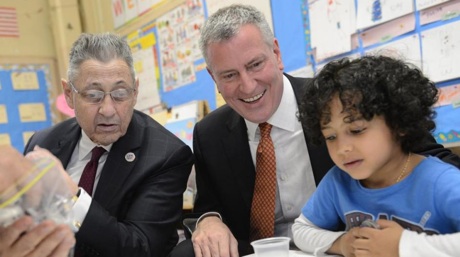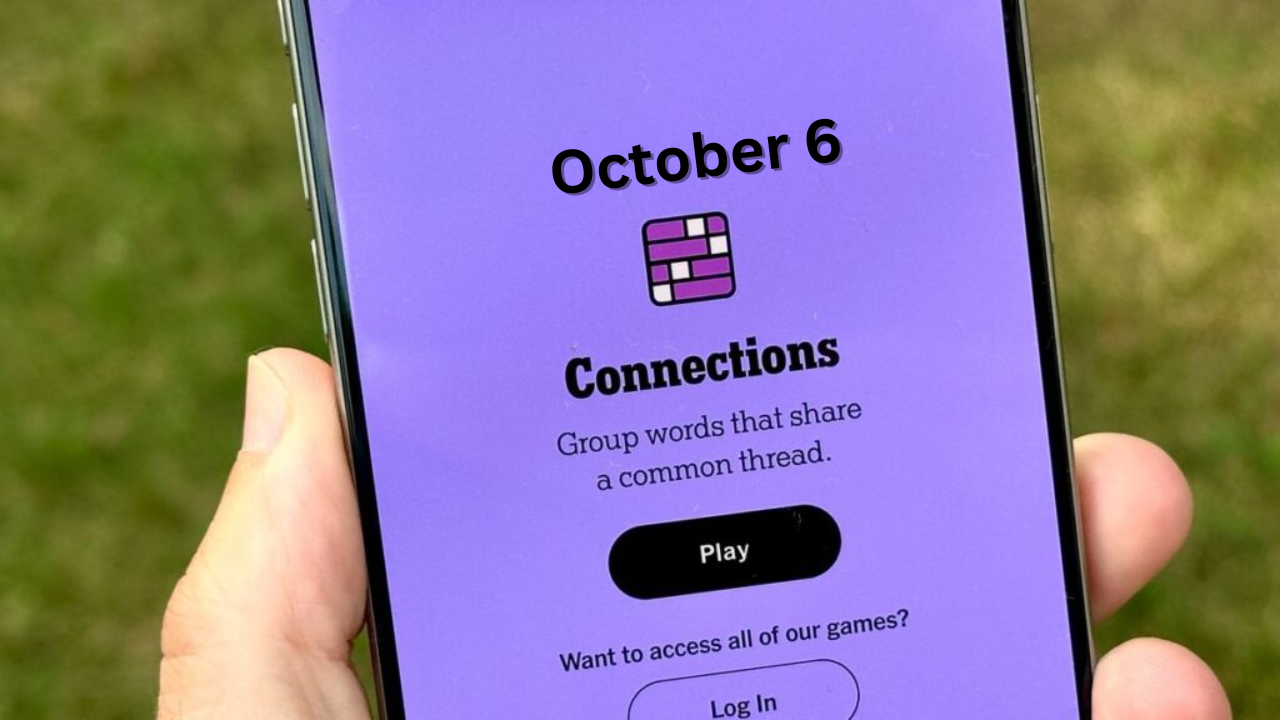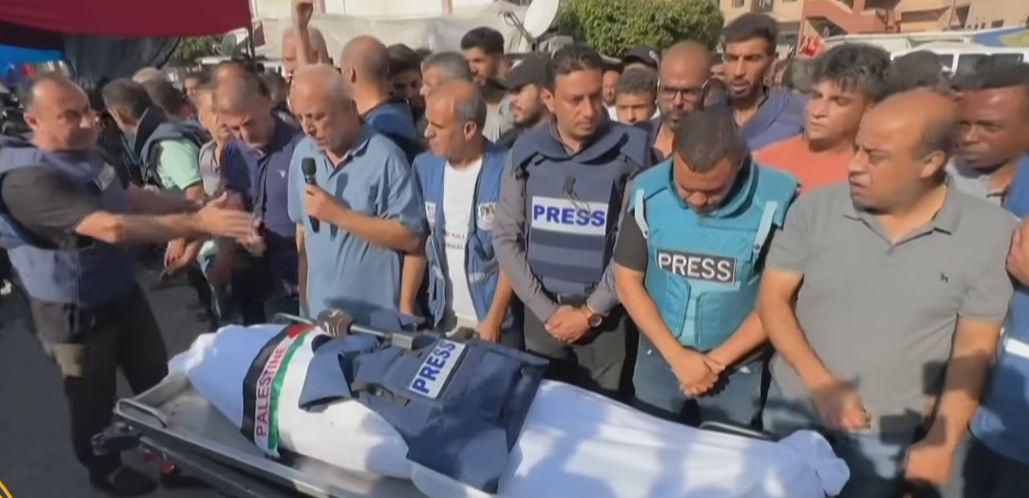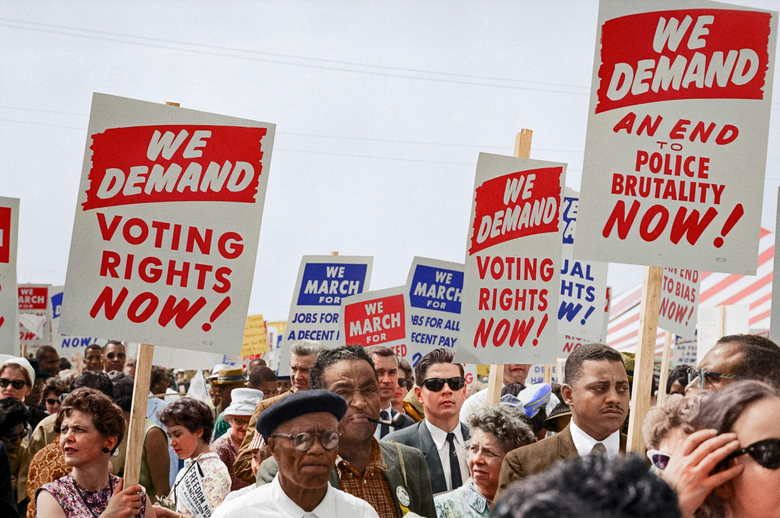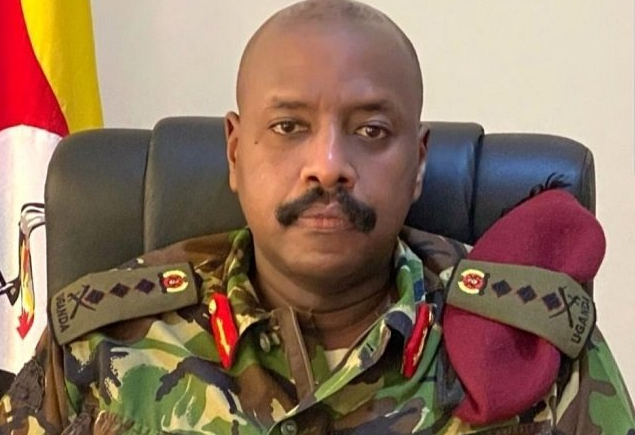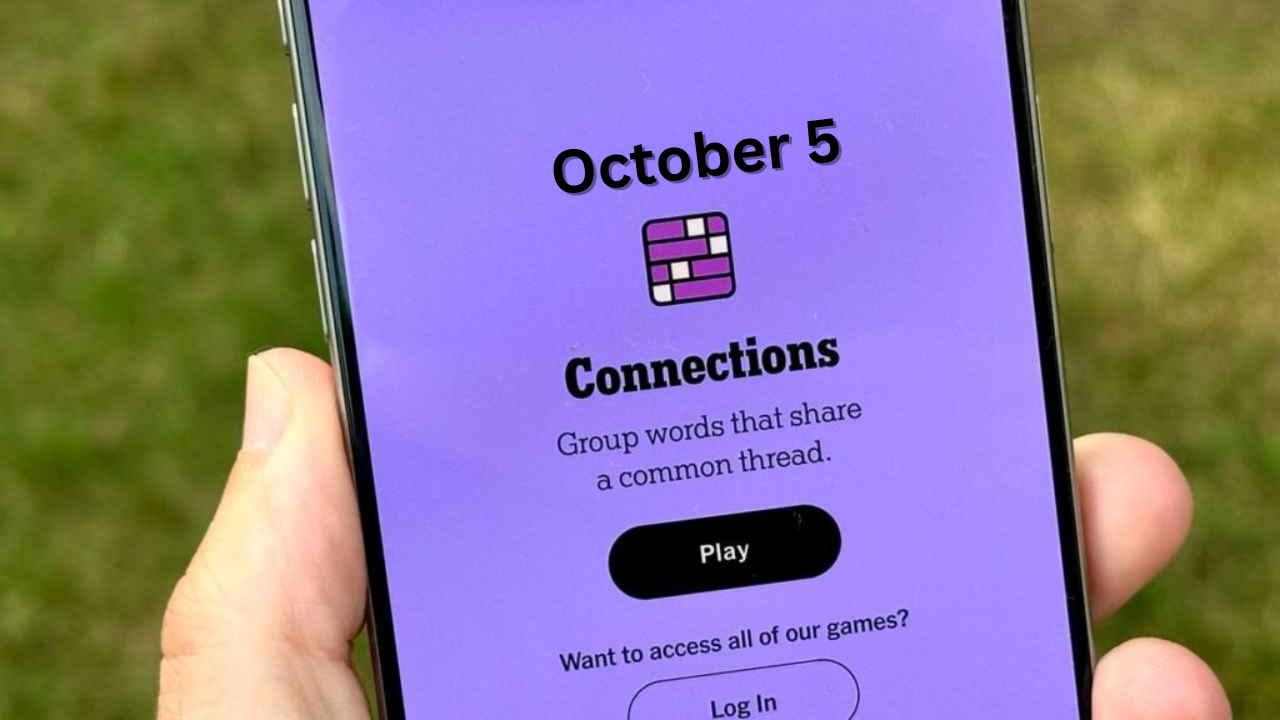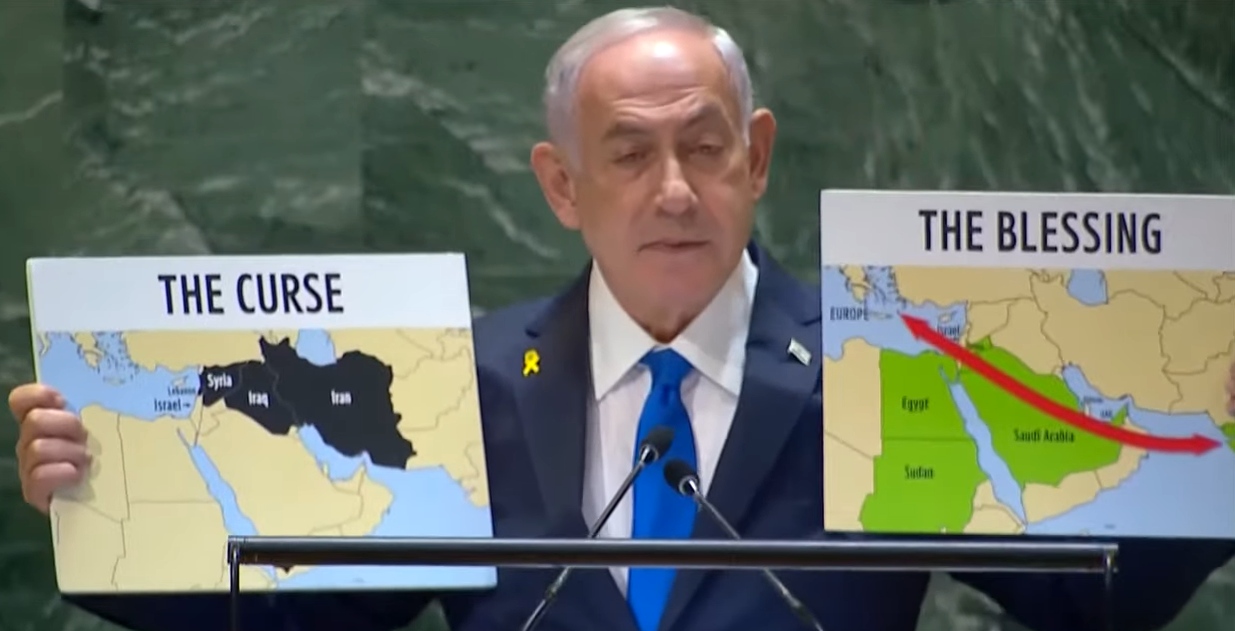Sheldon Silver, Mayor de Blasio and a young student
[City Hall]
Mayor de Blasio: I’d like to thank everyone here at PS 1, starting with the superintendent for this district, Mariana Guzman, and the principal, Amy Hom. Thank you so much for your leadership and your welcoming of us. I’m very, very pleased to be standing here with the man who represents this district, Speaker Shelly Silver, and I have a lot to say in a moment about what he has done to bring us to this day when we’re finally moving forward to full-day pre-K for every child in this city and after-school programs for middle school kids. I want to thank the man who is going to be responsible for making this all happen on the ground, Deputy Mayor Richard Buery, and our DOE Executive Director for Early Childhood Education Sophia Pappas. Where is Sophia? Come on up Sophia, don’t be shy.
So PS 1 is a great school, a beloved school in this neighborhood with a great principal. And we thank Amy for the great work she does. And this is a very good week for this school. Because next year it’s going to be able to serve even more children with full-day pre-K. PS 1 is going to go from having three pre-K classrooms to four pre-K classrooms, all in a community full of children learning English as a second language. Which means the pre-K is going to be even more important for the parents of this community. And I want to take this moment to thank the parents who have joined us today. That we really appreciate their involvement and their support, and I urge our friends in the media to talk to some of the parents about their experiences. And you’ll hear what a difference full-day pre-K makes in the lives of children.
It makes a difference for the entire community, for the teachers and everyone else in the school who work so hard to give children a good education. That early start will make such a big difference in the ability to reach kids and get them a great education. Certainly for parents and their lives, full-day pre-K will make such a big impact, something they can plan around and depend on. And you’ll start to see the difference this September when we bring the number of pre-K seats up to our goal of 53,000 – 53,000 high-quality, full-day pre-K seats. And then in the following school year, up to the total that we are shooting for, 73,000, meaning every child in New York City is accommodated with full-day pre-K. We announced yesterday the first seats being available for application through our public schools. As we said, thereafter there’s going to be an application process involving community-based organizations.
And it’s very fitting that we’re here today in a school that’s going to directly benefit, in a school where parents have been asking for more and more opportunities for pre-K. This school, PS 1, is going to be an example of what we are able to achieve with full-day pre-K. It’s also important to be here because, as I mentioned, we’re in the home district of the man who’s done the most to advance the cause of early childhood education in this state over the last two decades. And, you know, Speaker Silver, I think we can agree with the old truism that success has a thousand fathers and mothers. But the truth is for not just years, for decades, you have been fighting to make truly universal pre-K a reality in this city. And it’s something that – I think I have my facts right, you started talking about in 1996. You went through years of hearing from the rest of the Albany establishment that someday we’d get something done. You were the one voice – and I want to say thank you to the whole assembly – that stuck with this over years and years. I think, if I’m counting correct, over four different governors. And kept the flame burning, kept the idea intact that we have to get here for the good of our children, for the good of our families.
If we’re really going to fix our public schools, we have to get to full-day pre-K for all. And sometimes in the day-to-day fray we forget that someone had to get the ball rolling. Someone had to take an unconventional idea and bring it into the mainstream. Someone had to set the pace and put the demand forward that eventually won the day. And that person is Speaker Shelly Silver. So, I have to tell you, if he had not persisted, if he had not made it his life’s work to stand up for universal pre-K, we would not be standing here today announcing the results of this victory. Literally would not have been possible if Shelly Silver had not started this work years and years ago, and he deserves a round of applause for that for sure.
[Applause]
Now this year there was a great consensus in Albany. It started with the assembly taking bold and decisive action. The senate came on board. The governor believed in pre-K for the whole state, and I commend him for that. And everyone got on the same page. And that is the story of how we got to the day where we actually start to now apply this on the ground to people who need it. We can say, you know, $1.5 billion over five years. We can say $300 million a year. Those are abstract numbers. I’ll tell you in human terms, they’re vastly important. Because we have a five-year commitment, we’re now going to be able to achieve this goal of full-day pre-K for every child – high-quality pre-K for every child. This is going to change this city for the better. It’s going to have a lasting impact. This is one of those moments in history where things changed for good. And the reason that has been possible is because one man stood up long ago and said that someday he would make it so. He’s kept his promise, Speaker Shelly Silver.
State Assembly Speaker Sheldon Silver: Thank you very much. Thank you very much Mr. Mayor, certainly for your kind words and acknowledging the leadership of the assembly, my assembly colleagues and myself in establishing universal pre-K in the state of New York. I’m delighted, obviously, to be here at PS 1, one of my hometown’s truly wonderful public schools. And I join you in urging parents to please enroll your young children in one of our new, publically funded full-day pre-K programs. You know, I am truly in my hometown. My family lived on Henry Street when I was born, a little further down. So, you know, this is all – I never left [inaudible]. And I didn’t have the benefit of pre-K when I grew up, but somehow I succeeded, I think. [inaudible] as far as that goes. But what’s important is that we get the message out to parents.
The students of PS 1 are already competing for the jobs of tomorrow, competing with children from around the globe. You know years ago, we competed with New Jersey, maybe South Dakota. Today we’re – they’re competing with the children in Europe for the jobs two decades from now. Today’s pre-kindergarteners are the New York workforce 20 years from today. We have a great, great university system in New York State. What we need is kind of like building a building. You don’t build it from the roof down. You need the foundation, and pre-K is that foundation. So we really need to give our children the best opportunity to win the competition so that New York can win the competition 20 years from now. And pre-K is that critical jumpstart to our children. And they need it and they deserve it and every study will tell you, pre-K works.
So that’s what makes the $2 billion Smart Schools bond act, which came with the budget – it’s also important because it gives the same thing – students across the state, the latest educational technology to help New York City alleviate school overcrowding and to get our students – our workforce of tomorrow – out of school trailers, where they are in certain places, and into proper classroom learning environments that they deserve. You know, children should not learn math by counting the raindrops that are leaking through the roof. They deserve a real environment, and hopefully this mayor’s vision – and with the resources that we gave him in this budget and budgets to come – will be able to provide that environment that goes with starting at pre-K.
So as the mayor said, 17 years and four governors ago, I and my assembly Democratic colleagues listened to the experts who said a quality pre-K program can lead to higher math and reading scores and long-term academic achievement. Year after year, with the leadership of the chair of our assembly education committee, Assemblywoman Cathy Nolan, we fought for additional universal pre-K funding because we would not surrender our belief that the benefits of early learning are the brightest – are the birthright of each and every child. Then last fall, what really was significant, we named a new partner, a powerful partner. And with his leadership, with his courage, he made universal pre-K the centerpiece of his mayoral campaign. And, obviously, it was a winning mayoral campaign – an overwhelming number of the people in this city said, yes, that man is right, he’s right to be our mayor. And the centerpiece of his campaign is what we’re here celebrating, really, today.
So, he gave the impetus to everybody across the state to begin talking about pre-K. And I’m proud that thanks to our partnership – and I – at best, you know, it was a partnership – that the new state budget contains that $1.5 billion over the next five years to establish full-day pre-K programs in the City of New York. And I’m confident that this mayor will enact the appropriate procedures to make sure that every one of those dollars is spent in high quality, full-day pre-K across this city.
So, it was a tremendous victory for our children and, as I said before, a big chunk of that credit for the victory goes to the mayor here. We look forward to working with you, not only on this, but making this program a success, but a lot of other things that have to be done for this city. We’re there to help you do it as best we can. And I believe that years from now, we’ll look back on this moment as the beginning of a new era in New York – an era where the potential contained in each and every young mind is truly valued and our city will be better off for it. So, congratulations, Mr. Mayor, on a job very well done.
Mayor: Thank you. And I have to tell you – thank you. I really want to say – the Speaker mentioned partnership. It was an extraordinary partnership. It was a joy to work with him on this. He’s always looking out for the children and families of New York City – that’s what it came down to. Always kept his eye on that ball. And over these last weeks and months, we spoke a lot of times about how to get this done, and I know, from Speaker Silver’s point of view, it was about delivering for the children and families of this city. And that’s what happened.
I have to tell you, the concept of early childhood education, what it means to us – the speaker made an important point about the dynamics of the modern economy, the competition we’re facing now – the City of New York is facing all over the world, competing with cities around the world. I just want to say it very simply, I think there’s three levels to think about here. In the first instance, the availability of full-day pre-K immediately improves the lives of children because they’re learning more and better, more hours in school, getting that strong start. It immediately improves the lives of parents because they have something they can rely on in their complicated, difficult lives – knowing their kids are safe and are learning. So, that’s the first phase. That happens right away.
Over the years immediately ahead, more and more kids getting that early childhood start means they come into our school system ready to learn better and that starts to improve our school system overall. So every new wave of children, every new year where we’re reaching more and more children with full-day pre-K is going to improve the quality of our school system for everyone. And then, look ahead, as the speaker said – literally 20 years ahead – the future of New York City. And the future of New York City 20 years from now will be much brighter because we’ll have a much more educated work force. We’ll have a group of young people leaving our public schools ready for the modern economy in a way that just isn’t true today. So there’s so many elements of what we’re achieving here today and it will have such a lasting impact.
Now, Speaker Silver did his job for the people of New York City. And I thank him for that. And now, the ball is in our court to deliver, to make this happen on the ground. That’s where Deputy Mayor Buery comes in, that’s where Sophia Pappas comes in, and our chancellor, Carmen Fariña, and all the good people across all of the agencies who are working, literally night and day, to make the pieces come together for our children. Let me go over some of the steps that we’re taking right now to make sure parents know – that for the first wave of applications the deadline is April 23. Really want to make sure we get that out clearly. We’re going to do a lot to do that through all the means that the city government has at its disposal. I’m asking our friends in the media to please emphasize that in your coverage. Again, that is the first opportunity for people to apply. There will be other opportunities immediately thereafter with pre-K programs in community-based organizations in every neighborhood of this city.
And we are going to amplify that April 23 deadline with a variety of tools. First of all, a campaign – an ad campaign called Opportunity Starts Now. Opportunity Starts Now, which will be – it’s already started to be, and you’ll see more and more of it in our subways, our buses, and on our bus shelters. We’ll have a 30 second public service announcement on our taxis, with Taxi TV. There’s going to be a particularly compelling announcement – one I am particularly fond of – on the 3-1-1 system. It’s going to have the mellifluous voice of Chirlane McCray, our First Lady. When you’re on hold with 3-1-1, the First Lady will tell you how to apply for full-day pre-K for your child. And her voice convinced me long ago – I think it will convince parents to go immediately and apply. And, while we’re talking about 3-1-1, operators now have instructions about how to direct people so that they can get information on which sites are available and on how to apply. So, 3-1-1 will be a tool for any parent who wants to apply for pre-K.
We believe in all of those technological approaches to getting the word out to people, but we also believe in the old school approach – I think Speaker Silver and I both learned early on in our careers about the value of knocking on doors and standing outside of the subways and at bus stops – and so that’s going to be happening too. That’s going to be directed at people all over this city, including in some of our immigrant communities, our lower-income communities, we want to use every tool to get the word out. So we’re going to have a guide that we’ll be giving out. It will be in nine languages, including Spanish, Arabic, Bengali, Chinese, French, Haitian-Creole, Korean, Russian, and Urdu. And parents will be able to apply for pre-K in any of these languages.
We will be working with our library system to get information available in all libraries. We will be working with the housing authority to make sure that all residents of the housing authority who have children come into the pre-K year. We’ll have information on how to apply – they’ll be receiving a robo-call. Some materials will be available in those buildings. And our schools – in our public schools – our parent coordinators, who really do extraordinary work informing parents of the things they need to know – parent coordinators all over the city will be tasked with making sure that families get information on how to apply for pre-K for their younger children coming up to the pre-K age. Finally, our community affairs unit is going to be partnering with civic and cultural organizations all over the city. Every background, every neighborhood to get the world out. They’re today out in Queens providing information to the Korean community in Korean. They will be tomorrow in Brooklyn providing information to the Russian community in Russian. There’s many things that will be done to get the word out but the most important thing, as always in human life, is for everyone to talk to their friends, talk to their neighbors, talk to their family members. Let them know pre-K is available on a much greater scale for this September. It will grow even more thereafter and the time to apply is now.
By the way, again, for anyone who likes the technological approach, a couple of ways that people should know they can get information. They can apply – obviously – they can apply online, at schools.nyc.gov/prek – that’s with no hyphen, just P-R-E-K. So, again, schools.nyc.gov/prek. You can text the word “prek” – again, no hyphen – P-R-E-K – to 877877 to get information. Or, if you want to go in person, you can go to one of 13 enrollment offices across the city. To get information on those offices or any information about how to sign up, you can call 718-935-2009. 718-935-2009. Or, again, use schools.nyc.gov
So all of those approaches are going to saturate this city – and I know our colleagues from the assembly and all of our colleagues in elective office are working with us to make sure their staffs are going out across communities to get the word out. We have three weeks for parents to apply for this first wave of new pre-K seats. We want to make sure the word gets out with every tool.
Before we go to questions, just a moment en español.
Estoy muy agradecido del presidente de la asamblea estatal Sheldon Silver. El ha trabajo muy duro por la ciudad de Nueva York. Es por el que ahora mucho mas ninos podran ir al prekinder. Estamos trabajando juntos para asegurar el exito de todos y cada uno de nuestros ninos.
With that, we welcome on-topic questions first. On-topic. Jonathan?
Question: [inaudible]
Mayor: I’m sorry, say again?
Question: [inaudible]
Mayor: I’m going to start. I’m going to look to Richard if he wants to add. The initial source of that money is money that was already in this year’s DOE budget for promoting opportunities for children and parents, including the existing pre-K programs before this legislation was passed. So that’s where most of the money comes from. We’ve added a little bit from the DOE budget to that to make it fuller. On the question of TV ads, you probably know more than I do on that one.
Deputy Mayor Richard Buery, Strategic Policy Initiatives: Sure. There aren’t TV adds right now, but we are exploring TV ads. We’re going to explore other ways of accessing media, whether it’s social media, traditional media, grassroots, as we said before. This is a long process. April 23 is the deadline for the school-based slots, as we all know. We’re moving from 20,000 slots currently, full-day slots, to 53,000 full-day slots in the fall, to 73,000 full-day slots next fall. There’s a whole a process this spring after the school-based sites to enroll and get the word out about our community-based organization sites. So there’s lots more work to do to get the word out. We’re certainly relying on you all to help get the word out as well. So, we’re considering television, but as a part of a broad strategy to make sure that every New Yorker, every parent of a 4-year-old, knows about this amazing educational opportunity that’s coming their way.
Question: [inaudible]
Buery: [inaudible] I mean, we expect – I mean, frankly, we expect more applications that we have school-based slots. I mean, there are – which is always the case and we expect it to be true this year, as well. And part of our job is making sure that all those parents – even if you don’t get a slot in a school-based program – part of our job is making sure they’re aware of the other opportunities. Because, there’s going to be so many more opportunities now than there ever have been before. And so making sure that parents are encouraged to apply and encouraged to get their name on the list. And that’s our job for the next several months.
Mayor: Let me add to that quickly. The – and let me speak as a New York City public school parent, having gone through lots of different application processes with my two children. So this deadline – April 23 – is the first wave in terms of the public schools. Again, right after that, community-based organization options start to come online. People are going to see several waves of different options. Again – all neighborhoods, citywide. Remember that what also happens, is that after the first wave of acceptances – for example, at the public school programs – kids will get accepted as normal, and then there’s still some movement thereafter. A child, for example, might get accepted to their local pre-K then their family might move or they might decide on a different option even though they applied. And then seats become available again. So there’s going to be a certain amount opportunity throughout the spring. The important point is parents should apply to any and all options that they think will work for their child, because there may be more than one way to win. Andrew?
Question: [inaudible] as we all know, was not successful this year. Did you review [inaudible]
Mayor: Thank the assembly for their support of that idea.
Question: [inaudible] more sustainable source of funding for UPK?
Assembly Speaker Silver: Well, I think we’ve achieved the $1.5 billion over five years, appropriated. And we’re only allowed to appropriate two years at a time. And two years of that is appropriated in this budget. I think the important thing, for me, for the mayor, and for anybody associated with this, was having a fund to rely on so you start a program, you make the investments – in either physical plant or whatever – knowing that next year, the money will be there also, and into the future. So, I’m satisfied that we are going to have $300 million a year in the next five years, every year to run this program. I’ll also tell you that as part of the state budget, we increased the city’s share of state education – I should say the amount the city gets in terms of state education, by close to $400 million. That’s additional resources that have nothing to do with this particular UPK program, but it is general aid to the city for education purposes. It includes after-school programs and the city can use it if it needs it for additional pre-K as well – in addition to paying teachers and lowering class size or whatever they wish to do with that money.
Question: [inaudible]
Silver: [inaudible] Yeah.
Question: [inaudible]
Silver: Right now it’s an election year. We don’t – people don’t think beyond that.
Mayor: Yeah, right. Yes?
Question: [inaudible] Will there be a simple lottery process, or [inaudible]
Mayor: Yeah, we can get you the whole break out, but the bottom line is, it parallels the exact process that exists right now for pre-K seats in the public schools. There is a priority structure coming from the school zone. I’ll say this, and Richard or Sophia will correct me if I’m wrong – I think I’m right. Coming from that school zone and having a sibling already in the school is the highest priority, correct? And then from there, for example, coming from the school zone but not having a sibling is a higher priority than coming from outside the school zone. So it’s a set of criteria have been historically true that we’re going to continue to follow. Yes?
Question: Mayor, You had asked for approximately [inaudible] million over five years. [inaudible] about $300 [inaudible] Where are you going to find that money [inaudible] city money [inaudible]?
Mayor: Well, we’re working now to take the information from the budget and analyze it and make decisions about how to proceed. There’s still a lot of information being worked on out of the budget process. It’s a long and complicated document. I think we can agree on that statement. But look, we’ve got the vast majority. And we certainly have what we need to get this program up and running full-bore for this September and that’s what matters. On-topic.
Question: [inaudible] too late [inaudible] to let parents know [inaudible]
Mayor: Okay. I’m going to start to – I’m going try and speak as a parent, layman, and then the experts will jump in. When you’re a New York City public school parent looking for the specific opportunity you want for your child, you quickly learn that the situation is on-going. You try and get what you’re looking for as quickly as possible, as early as possible in the process. As I said, seats keep opening up for very natural reasons. Families move, you know. For whatever reason, a family declines a seat that they had gotten. That can even happen well into the summer in some cases. That is clearly the minority of seats I’m talking about, but what I’m trying to get across here is – you apply for as many good options as you can. Hopefully you get one of those in the first instance. Even if you don’t in the first instance, there’s still some opportunity thereafter, and you stick with it. The other point that’s obviously crucial to say is – we were determined from the beginning not to do this on a sort of pilot basis or limited basis or just in a few districts. We said from the very beginning, this is going to be truly universal. I’m going to pick up on the spirit of what Shelly Silver started talking about in 1996 – making the word universal true for the first time. And that meant two jumps – 53,000 this September to 73,000 in the following school year. So I think parents should be doing everything they can right now to apply for all the options. If for some reason they don’t get in this time, there’s going to be even greater opportunity going forward for any other of their children coming up to pre-K age thereafter. You guys want to add?
Sophia Pappas, Executive Director, Office of Early Childhood Education, DOE: So, we want to make sure that families have as many opportunities to understand their options and pursue their options as possible. As the mayor said, this is the first wave of that. After that June period when parents pre-register based on their matches from this application, then they can go directly to the school. And they can continue that through the start of the school year. And then for the CBOs, once we make those options available, they can then go directly to the CBOs. We really encourage families to look at all of these options over the next several months. And we look forward to – at the DOE and in collaboration with other agencies and community partners at every turn –making sure that families have all the information they need to understand their options and to find the best option for them and their child.
Question: [inaudible] collecting data on the first group of students who go through this [inaudible] however else you plan to measure [inaudible]?
Mayor: Absolutely. I’m going to start – and then Richard, jump in. We’re very devoted to high-quality. I want to be really clear about that. We said from the beginning, this was going to be based on the Common Core curriculum. And, put aside the question of testing in the curriculum, just stay on the curriculum itself. The notion of Common Core is a good and valid one. It’s saying we have to start bringing our whole school system up to the standards of modern life from the modern economy. And that starts at the pre-K level. We will not be doing standardized testing at that level. We will use the curriculum. It’s a good curriculum. It’s the State Department of Education-approved curriculum. And, we’re going to constantly work at quality. That begins with the highest quality teachers being chosen from the beginning. There will be on-going teacher training efforts. We want to make sure in everything we do that it’s never static, meaning, we start with what we think is the best way to create across the board, high-quality pre-K, and then we continue to upgrade it from then. We’re going to use a lot of different measures to determine how we’re doing and how to keep upgrading. But I think it’s very fair to say – we think this is both a qualitative and a quantitative exercise. If the past reality was the vast majority of kids did not get full-day pre-K. So you already lost on the quantitative, because you weren’t even putting kids in the classroom for enough time to have the impact you needed to have. The qualitative, though, is also crucially important. And it’s something we’re going to keep working on throughout.
Deputy Mayor Buery: Thank you. I mean, the mayor really said it all. All I would add is, in thinking about quality – quality, first of all, starts with selection. So the selection process – both for schools and community-based organizations – is intensive. Not everybody that applies can open UPK classrooms. So it starts by making sure that you bring in schools and community-based organizations into the system, who can demonstrate the ability to operate high-quality programs. Then you think about the other thing that impacts program quality. The mayor talked about teacher selection, teacher support, teacher training – a big part of this work – curriculum support, curriculum development. The Department of Education is also focused on beefing up its staff so that you have a team of coaches who are going out and visiting programs regularly, supporting programs, to help them to improve implementation, to make sure their program they’re running well. So the whole design of the program is ensure high quality delivery of programs.
Then I would say more broadly, as a system, we’re committed to evaluating the programs as a system – system-wide, because we know that as good as we are on day one, it can only get better. And so we’re really committed to putting in the resources ensuring we’re able to evaluate the program for purposes of improving quality for children’s families over time, and demonstrating to everyone that this really is the great investment we know it to be.
Question: [inaudible] one-stop shop [inaudible]
Mayor: It’s a very fair question, but our job is to make it clearer and better throughout. I’ve had a lot of conversations with my colleagues from a parent’s perspective – about wanting to make sure we provide maximum support for parents in this process. That’s why now 3-1-1 is going to be a part of the process, for example. That’s why the materials are going to be in multiple languages. That’s why we’re getting parent coordinators involved. Parent coordinators – a great example where it’s the human factor – they know the parents of their community, they’re talking to them directly, they’re helping them through the application process. So, I think we obviously needed to make sure we had the funding. We didn’t have the luxury of knowing until a few days ago if we would definitely have the funding. But we are convinced that we can use the previous process effectively in terms of the public school applications. And then for the others at the community-based organizations, we can provide a lot of support and a lot of facilitation to make sure that goes well for parents.
Question: [inaudible]
Mayor: Absolutely. This is one – Look, this is our number one initiative. I appreciated what Speaker Silver said. This is what I came here to do. I think I made that rather clear last year. And we’re going to make sure it works. We have incredibly talented people working on it. We have a lot of people working on it. And we’re going to be looking all the time for anything that is not working up to our standards. And part of why, again, parent coordinators, the community affairs unit, so many people out there – obviously, elected officials and their staff – we want to hear their constant response and their feedback about what’s working and what’s not, because we can do a lot to keep making adjustments so that it is clear. Okay, off-topic.
Question: [inaudible]
Mayor: Are you leading the witness?
Question: [inaudible]
Mayor: Let me separate the procedural issue from what our goals are. The procedural – obviously that Bond Act has to pass. And, you know, we’re very hopeful it will and I’m going to certainly work every way I can to get it passed. But it has to pass. So we don’t count on anything until it’s done. The speaker has been very consistent.
Question: [inaudible]
Mayor: Well, again, we believe there’s a good chance of it. But in terms of making any final plans, we have to see it pass. The speaker has very adamantly, in these last months that we’ve been working together so closely, raised the issue of the overcrowding and the trailers. And that afflicts some areas – Central Queens is a particularly important example of an area that really needs help. A lot of kids are in trailers, a lot of kids are in very overcrowded schools. We have to address that issue. The chair of the education committee, Cathy Nolan, has been very strong on this issue as well. And we share that concern. It’s one of our priorities with our existing education capital budget and any new resources that we’re hopeful we will get to be able to address the overcrowding issue. I don’t want kids in trailers. I want to move aggressively to get them out of trailers. We know that will take some time, but we’re committed to it. We’re also committed to putting in new facilities in the most overcrowded areas. Central Queens is an example, Lower Manhattan is an example, of profoundly overcrowded dynamics with schools – lots of demand going on that we have to address that. So, that will be a big focus as we go forward.
Question: A federal appeals court ruled today that [inaudible] could bar religious groups from using their facilities to hold services. Are you going to [inaudible] schools should allow religious groups?
Mayor: I haven’t seen the ruling. Obviously, Zach Carter will look at it and we’ll assess from there. I stand by my belief that a faith organization playing by the same rules as any community non-profit deserves access. You know, they have to go through the same application process, wait their turn for space, pay the same rent – but I think they deserve access. They play a very, very important role in terms of providing social services and other important community services. And I think they deserve that right. But we’ll assess the court decision and we’ll look from there.
Question: [inaudible] letters from select officials [inaudible]
Mayor: Yes, I have.
Question: [inaudible]
Mayor: We’re not to the point of issuing a firm position because we’re still researching the situation. I definitely have talked to some of the elected officials locally. They’re passionate on this issue. But we haven’t had an opportunity to assess all of the reality, including how the previous administration got to this point and what their reasoning was and what it meant for the park and the city going forward. So we have to do that full analysis, and then we’ll come out with a position.
Question: [inaudible] it was something that the Bloomberg administration –
Mayor: Say again, a tax break for?
Question: Condo development up in the Bronx.
Mayor: Condo?
Question: Yeah [inaudible]
Mayor: Yeah, I don’t know the development. So you can ask the question, but I just want to tell you from the jump I don’t know the specifics of that situation.
Question: I’m just going to ask if you’ve [inaudible] signed off on [inaudible] Bloomberg Administration [inaudible] $17 million [inaudible]
Mayor: We’ll get you more information on that. Yes?
Question: Mayor, today Commissioner Bratton is meeting with Reverend Sharpton [inaudible] racial profiling for [inaudible] In your view, how much of a problem is it and what would you like to [inaudible]
Mayor: It’s a real problem. Obviously a lot of people were treated inappropriately. You know, a lot of people were put through a very painful experience of being treated like they had done something wrong when they were law-abiding citizens who – I know in at least one or two of these cases that were well-publicized, people who had paid with their own credit card, and then were treated like second-class citizens. It’s absolutely unacceptable. And so I think it’s very important that that meeting is happening. I commend Commissioner Bratton. I think he’s done an extraordinary job of, you know, making clear that we’re going to work very, very hard to create a fairer city. And that we want to bring police and community together, and this is another piece of that equation. And obviously, working with the stores to let them know how important it is to treat everyone fairly and consistently.
Question: [inaudible]
Mayor: What’s the name again?
Question: [inaudible]
Mayor: I don’t know that one. Same category, we’ll get back to you. I don’t know that particular case. Obviously you know from the work I did as advocate, we are very forceful when it comes to landlords who have not been following the law. So that’ll be our stance again, but we’ll get back to you the specifics of that case. Thanks everyone.

